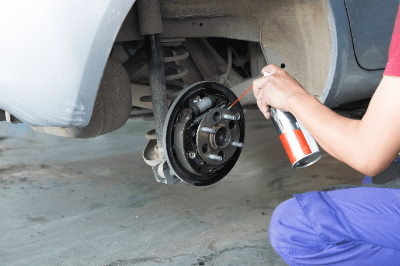What Is a Brake Cleaner?

Brake cleaner is a chemical product used for maintaining and cleaning automotive brakes.
Typically available in liquid form, it effectively removes oil and brake dust adhered to the surfaces of brake pads and brake rotors. Friction in the brake system generates heat, causing oil and dirt to stick to these surfaces, often leading to reduced brake performance and noise.
Brake cleaners effectively eliminate these contaminants, restoring brake efficiency. However, due to their high volatility and flammability, careful handling is required. They may also affect the car body and rubber components.
Uses of Brake Cleaner
Brake cleaner serves various cleaning and maintenance purposes:
1. Cleaning Brake Pads and Rotors
Over time, brake pads can wear down, exposing metal parts, brake dust, and dirt. Brake cleaner removes these substances from pads and rotors, improving brake performance.
2. Cleaning Engine Parts
Engine parts, often contaminated with oil and fuel residues, benefit from brake cleaner application. It effectively cleans the surfaces of engine blocks and cylinder heads, simplifying maintenance and enhancing cooling efficiency.
3. Cleaning Electronic Equipment
Electronic components, prone to dust and oil accumulation, can have their performance affected. Brake cleaner helps remove these contaminants, though caution is advised due to potential damage to some materials.
4. Solvent Cleaning of Metal Parts
Metal parts and tools, when coated with oil and dirt, can be restored to a clean state with brake cleaner. It dissolves the dirt, maintaining the parts’ shine and durability.
Principle of Brake Cleaner
Brake cleaner’s primary components are volatile organic solvents, including acetone, methyl ethylketone, toluene, ethanol, and isopropanol. These solvents dissolve and remove dirt, oil, and other substances from surfaces.
They have a low boiling point and evaporate at room temperature, allowing quick drying after application. The key principle is their ability to dissolve foreign substances, such as oil and brake dust, which may oxidize or harden on surfaces.
By dissolving and vaporizing these substances, brake cleaner leaves surfaces clean and residue-free.
How to Choose a Brake Cleaner
When selecting a brake cleaner, consider the following factors:
1. Ingredients
While primarily consisting of volatile organic solvents, ingredients vary among brands. Check compatibility with the materials and components used. Environmentally conscious users should opt for low-VOC products.
2. Capacity
Choose a capacity based on usage frequency and purpose. Smaller capacities suit occasional small-scale jobs, while larger ones are better for frequent, large-scale maintenance.
3. Drying Time
Different products have varying drying times, influenced by environment and temperature. For quick reuse after cleaning, opt for a fast-drying product. However, always adhere to the user manual guidelines.
4. Operating Temperature
Performance varies with temperature. Warmer conditions generally enhance cleaning effectiveness due to faster solvent evaporation. In colder climates, choose a product effective at lower temperatures.